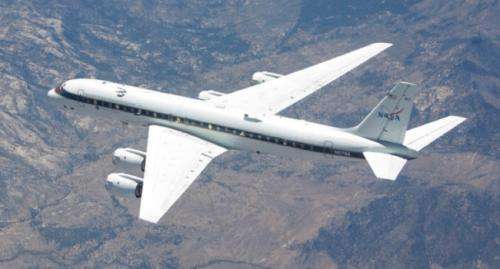Imaging the chemistry of the global atmosphere

With an airborne, globe-spanning study of the Earth's atmosphere, a Harvard-led team hopes to establish how air pollution from human activities reacts with greenhouse gases. The findings will develop the scientific foundation for near-term strategies to mitigate climate change.
The Atmospheric Tomography (ATom) project, led by Steven Wofsy, Abbott Lawrence Rotch Professor of Atmospheric and Environmental Science at the Harvard School of Engineering and Applied Sciences (SEAS), is part of NASA's Earth Venture suborbital investigations program.
Wofsy's team, which includes collaborating scientists from nearly a dozen universities and agencies, will send 15 sophisticated sensing instruments aboard a DC-8 jetliner, NASA's long-range research aircraft. They will collect detailed data in a series of flights stretching over five years and thousands of miles. Missions will take off from NASA's Armstrong Flight Research Center in California and fly almost to the North Pole, make a U-turn to the South Pacific, pass around Cape Horn into the Atlantic, travel north to Greenland, and return to California across North America. The plane's instruments will analyze gases and aerosols sampled at altitudes ranging from a 200 meters to 12 kilometers above the Earth's surface.
"You go around the atmosphere and you find a lot of chemically reactive gases globally," Wofsy said. "Some are produced by human activity and some are naturally occurring. We understand a great deal, but there are some real mysteries we're trying to address. Where do some key reactive chemicals come from? How do they change the chemistry of the atmosphere?"
The scientists will look at how air pollutants transform atmospheric chemistry and how these chemicals affect methane and ozone. The results will help improve the accuracy of the environmental models that inform government climate policies. The ATom project results will also supplement data collection at a time when NASA's atmospheric chemistry programs have fewer satellite resources available to watch the skies from orbit.
Wofsy has experience with large-scale atmospheric monitoring efforts; he was principal investigator on the HIAPER Pole-to-Pole Observations (HIPPO) project, which conducted research flights from the Arctic to the Antarctic over three years, mapping the distribution of greenhouse gases and particles that affect climate. Open-access data from those 64 flights provided important insight into the global carbon cycle and atmospheric aerosols.
Wofsy said he expects the first ATom flights to take to the skies in the spring or early summer of 2016.
The project is one of five new missions to receive support under NASA's Earth Venture program.
"These new investigations address a variety of key scientific questions critical to advancing our understanding of how Earth works," said Jack Kaye, associate director for research in NASA's Earth Science Division. "These innovative airborne experiments will let us probe inside processes and locations in unprecedented detail that complements what we can do with our fleet of Earth-observing satellites."
Provided by Harvard University



















